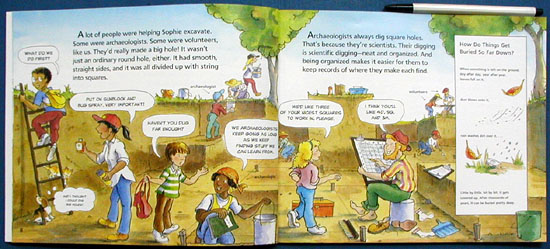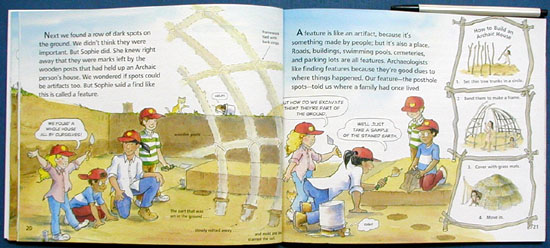|
|
|
|
 |
 이전 | 이전 |  목록 | 다음 목록 | 다음 |
|
|

상세그림 1 |

상세그림 2 |
|
확대 이미지 : 상세그림 1

|
확대 이미지 : 상세그림 2

|
[ 책 소개 ]
* A Reading Rainbow Book Selection
Harper Collins의 Let's-Read-and-Find-Out Science시리즈는 과학의 기본개념을 알기 쉽게 소개하며 어린 아이들의 과학, 기술, 자연에 관한 다양한 호기심과 궁금증을 해결해 줄 수 있는 우수한 어린이 과학도서입니다.
이 책에서는 고고학자들이 유적 발굴현장에서 어떻게 작업을 하고, 돌조각이나 뼈조각, 나무조각, 검게 탄 씨앗 등과 같이 하찮아 보이는 것들로 부터 어떻게 오랜 옛날에 살았던 사람들의 생활모습을 밝혀내는지를 쉽고 재미있게 소개합니다.
[ 서지 정보 ]
Edition: Paperback: 32 pages
ISBN-10: 0064451755
ISBN-13: 978-0064451758
책 크기: 25cm x 20cm
[ 영문 서평 ]
Book Description
Archaeologists on a dig work very much like detectives at a crime scene. Every chipped rock, charred seed, or fossilized bone could be a clue to how people lived in the past. In this information-packed Let’s-Read-and-Find-Out Science book, Kate Duke explains what scientists are looking for, how they find it, and what their finds reveal.
Children's Literature
Young readers learn all about the painstaking field and laboratory work of archaeologists and others who search for the remains of humans and animals and then try to understand how they lived. Activities are clearly described, terms are defined within the text, and it is liberally illustrated. A perfect choice for the curious and any kid who has wanted to search for dinosaur bones.
School Library Journal
This book has the appealing layout and tone of the successful "Magic School Bus" series (Scholastic), while still being firmly grounded in reality. Three children, a dog, and a cat accompany their archaeologist friend Sophie on a dig. The woman explains the scientific process, exuding enthusiasm for her chosen career. The inquisitive children, always referred to collectively, ask realistic questions in often humorous dialogue. Discussions regarding ancient and modern garbage are particularly amusing. Another nice touch is the discovery of animal bones, which are later reconstructed in a laboratory. The way of life practiced in the Archaic Era of 6,000 years ago is described via archaeological finds such as an awl and a stone knife. Students will find this lively book more fun than photographic treatments such as Dennis Fradin's Archaeology (Children's Press, 1983). Upbeat, conversational text, fact-filled sidebars, speech bubbles, and instructive illustrations provide a delightful cornucopia of information that students will return to again and again.
Kirkus Reviews
Readers will feel as if they're taking an active part in an archaeological dig in this informative entry in the Let's-Read-and- Find-Out Science series, reminiscent of Aliki's Digging for Dinosaurs and entries in the Magic School Bus series. Student volunteers accompany Sophie, the archaeologist, to an unnamed dig in a cornfield, where remains of people from the Archaic Era are being uncovered. Scientific information is spelled out in a straightforward text, defining terms, artifact, midden, and feature - as well as processes, e.g., wet-screening dirt. Dialogue balloons show the students' questions and reactions to their discoveries, while a pet beagle's comments provide comic relief. Inserts complement the text by highlighting comparisons between past and present, how tools were made, and what a basket of modern garbage can reveal. The need for meticulous record-keeping and expert analysis is also included: There is a behind-the-scenes look at a lab plus a complete picture of field work, including the long hours, hot sun, and tedious sifting of dirt. With her inviting approach to a complex process, Duke (Aunt Isabel Makes Trouble, p. 1398, etc.) ensures that this eye-opening field trip will inspire dirt diggers and treasure-seekers everywhere.
|
| * 최근 이 작품을 구입하신 분들의 다른 선택 |
Stone Soup
Caldecott 수상작, 페이퍼백 |
Miss Daisy Is Still Crazy!
My Weirdest School, Book 5, 페이퍼백, 슈퍼바이 |
The Happy Lion
페이퍼백, 슈퍼바이 |
Ms. Cuddy Is Nutty!
My Weirdest School, Book 2, 페이퍼백, 슈퍼바이 |
|
| |
|
|< << [1] [2] [3] [4] [5] [6] [7] [8] [9] [10] >> >|
|
|
|